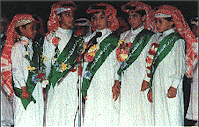|
|
General Education
 |
The Saudi education system instills a deep respect for religion and culture. |
The objectives of Saudi educational policy are to ensure that education becomes more efficient, to meet the religious, economic and social needs of the country and to eradicate illiteracy among Saudi adults.
General education in the Kingdom consists of kindergarten, six years of primary school and three years each of intermediate and high school. The Ministry of Education sets overall standards for the country's educational system and also oversees special education for the handicapped. The General Presidency for Girls' Education administers the girls' schools and colleges, supervises kindergartens and nursery schools and sponsors literacy programs for females. The first school for girls in the Kingdom was built in 1964, and education is now available for girls throughout the country. Of the 3.2 million students enrolled in Saudi schools in 1992, more than 44 percent were female. That percentage increases at the university level to more than 46 percent.
Students can attend either high schools offering programs in both the arts and sciences or vocational schools. In 1992, there were 613,000 students in intermediate schools and 313,000 students in high schools. Students' progress through high schools is determined by comprehensive exams conducted twice a year and supervised by the Ministry of Education.
The dramatic quantitative growth of the educational system since the introduction of the First Development Plan in 1970 has been more than matched by an improvement in the quality of education. One measure of this emphasis is that while the number of students in the educational system increased sixfold between 1970 and 1992, the number of full-time teachers grew more than ninefold.
The Kingdom's ratio of 15.1 students to every teacher is one of the lowest in the world. The government, however, continues to work to improve educational standards. This has been achieved by raising the quality of teacher training programs. improving standards for evaluation of students and increasing the use of educational technology, principally by introducing computer science at the secondary level. The administration of the educational system has also been enhanced partly by delegating more authority to the regional boards.
As part of its efforts to make education available to Saudi students residing abroad, the Kingdom has established three educational institutions in the United States, Britain and Germany. Students attend kindergarten through 12th grade at these schools, receiving instruction in Islam and the Arabic language, in addition to the regular curriculum. .
|